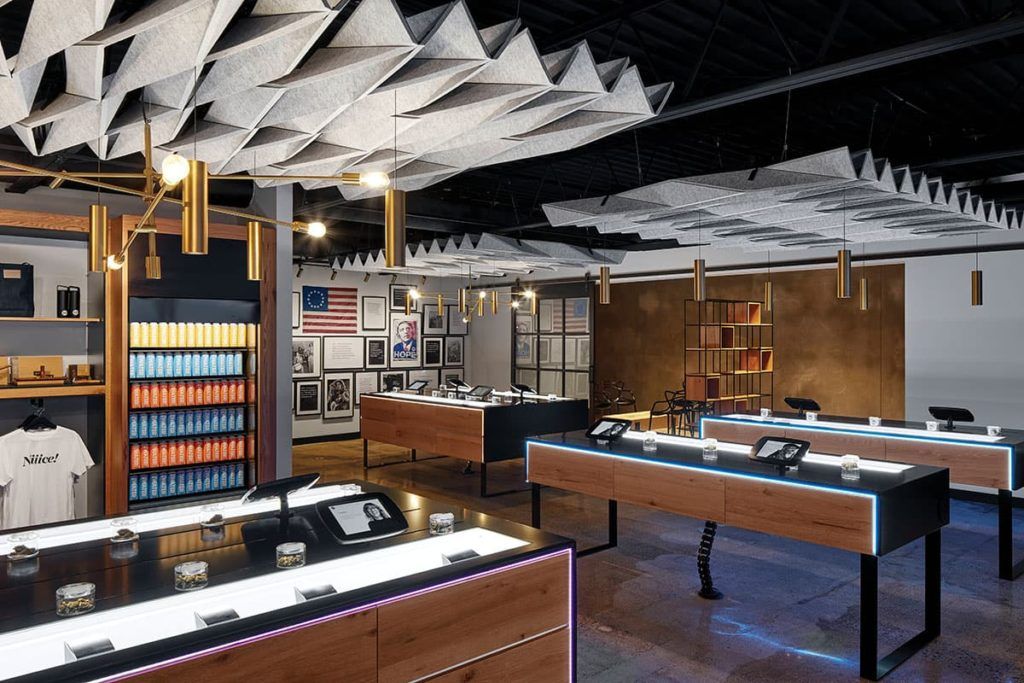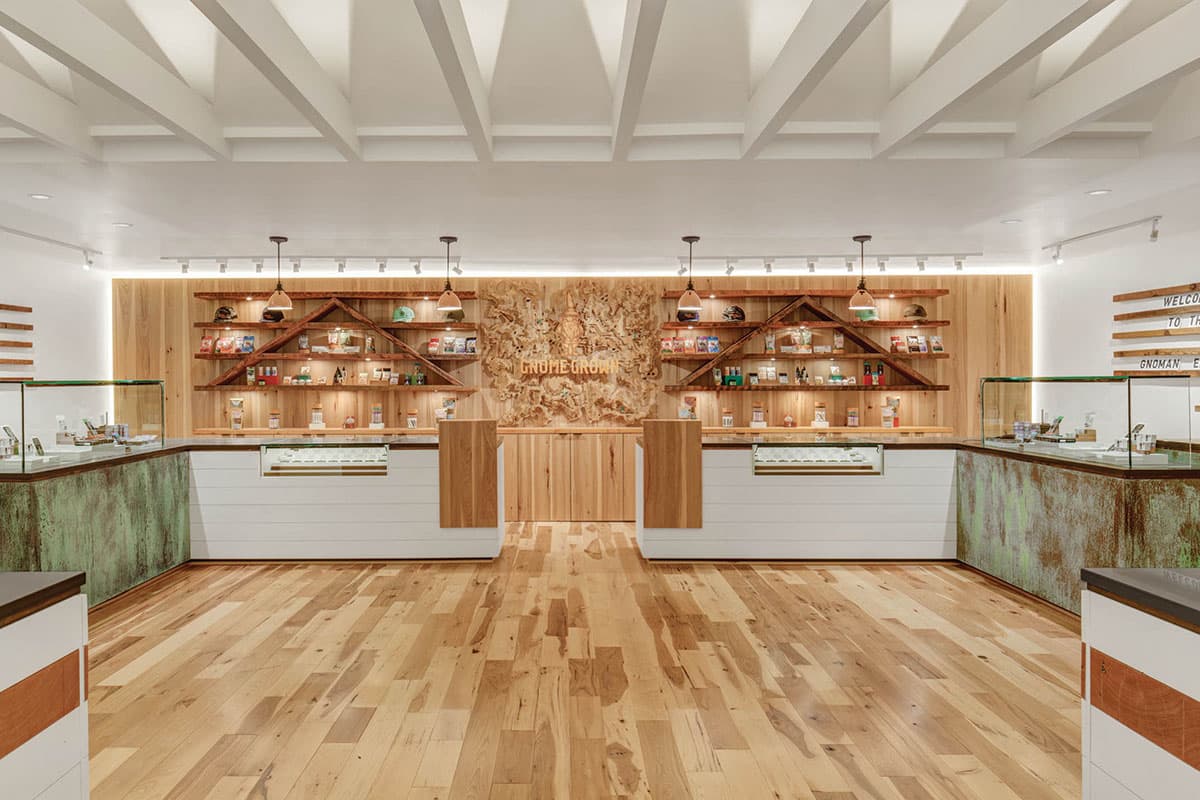(This story appears in the March issue of Marijuana Business Magazine.)
Marijuana still carries a stigma in many communities. Adopting the right design can make a cannabis store feel more comfortable for shoppers.
There’s no single right way to design a marijuana retail store. But making deliberate design choices that reflect your brand and values can build buzz, draw new customers and keep them coming back for more.
Design Insights
Veteran dispensary designer Megan Stone is the founder and creative director of Phoenix-based High Road Design Studio, which focuses on marijuana retail design and branding. Since launching the company in 2013, Stone’s team has worked on 62 cannabis retail outlets in 17 states.
After establishing the basic boundaries of a new dispensary project such as local regulations and the real estate itself, Stone said the next step is taking “a very close listen to the client’s brand and their story—and who they’re trying to be and how they’re trying to go about doing it.”
Although it’s hard to distill the entire spectrum of store design into only a few categories, Stone sees three broad archetypes for dispensary design, each exemplified by a High Road project:
High-volume retail: Happy Valley, a Massachusetts recreational marijuana outlet with locations in Boston and Gloucester, was designed with the goal of maximizing customer throughput.
To do that, Stone said High Road used express checkouts, separating the cashier from the order-pickup counter to speed up transaction processing time and minimize bottlenecks.
“They didn’t sacrifice the retail experience, either. They still have a beautiful showroom. The products are displayed very (nicely), and everything is behind glass,” Stone said.
Education-driven retail: Design centered around teaching is a good fit for medical marijuana dispensaries such as Maitri Medicinals in Pittsburgh, where Stone called the consultation-room experience “a cornerstone of our design.”
“The way we set up their merchandising really helps facilitate conversations about the products so that customers could ask and learn about all the different modalities of consuming cannabis,” Stone explained.
That educational approach was particularly important in Pennsylvania, she added, because the state initially didn’t allow sales of smokable flower. “Their brand is centered around educating on the plant, educating on how to consume it, educating on how it helps you, and our store design definitely had to relate to that.”
Experiential retail: Gnome Grown, an Oregon retailer with a whimsical, “very rich brand story,” illustrates a more experiential approach to marijuana retail design, Stone said.
“We really wanted to embody their brand: their organic nature, their stewardship to the environment, their dedication to quality and just their approachable, friendly ‘gnominess,’ for lack of a better term,” she explained.
To that end, Stone said her design team focused carefully on everything from finishes to furniture to fixtures, communicating “authenticity and craftsmanship and quality.”
Inspiring Calm in California
West Hollywood, California, retailer Calma has been dubbed Los Angeles’ “most inviting” cannabis shopping experience by LA Weekly.
The dispensary was designed to exude “feminine energy,” said general manager Mara Stusser.
The eye-catching pink exterior, decorated with monstera leaves, was hand-painted by a local female artist. The floors and fixtures are marble, and one wall of the dispensary sports an enormous LED video display that usually shows soothing nature scenes.
“The space itself is very welcoming. It’s very open, it’s very calming,” Stusser said.
She added that the elegant design—made visible by large, street-facing windows—helps lure passers-by.
“Sometimes people will say to us, ‘Wow, I just had to come in here because I didn’t know what this was,’” she said. “They have this curiosity, because they’re not used to seeing a cannabis retail store look the way that ours does.”
For other retailers just starting their designs, Stusser recommends thinking from a customer’s perspective.
“I feel that when you’re going into designing a cannabis retail space, you really have to think about your customer: What are they coming for? What do they want to see? What do they want to feel?” she said.
“I’m huge on making sure that your design speaks your brand and speaks for your mission statement.”
Minimalist High Design in Toronto
Cannabis retailer Edition opened in Toronto in December with fanfare from a variety of design-focused publications. Elle Décor declared at the time, “This may just be the world’s chicest cannabis shop.”
Edition founder and CEO Ryan Roebuck said he “wanted to break that stigma of what the traditional cannabis retail dispensary should look like.”
Roebuck said the design of Edition’s first location was meant to make a high-end retail experience available to cannabis shoppers—particularly an older, more affluent demographic that’s used to shopping at other luxury stores—without intimidating other customer demographics.
“Luxury, to us, doesn’t necessarily mean white gloves, silver trays (and) expensive prices. Luxury, to us, is an experience, impeccable quality and an overall beautiful environment,” he said.
Roebuck describes the store as light, open and airy. A custom scent, made in collaboration with Murphy & Jo Candle Co., pervades Edition’s space.
“When you deal with good designers and good architects, the questions that they’re asking at the beginning of the process shouldn’t necessarily be, ‘How do you want it to look?’” Roebuck said. “It should be, ‘How do you want it to feel? How do you want it to flow?’”
A Touch of Detroit in Flint, Michigan
Michigan cannabis retailer Common Citizen’s store in Flint won a 2019 Gold Award for retail store design from the International Council of Shopping Centers.

Common Citizen in Flint, Michigan, uses design and color to differentiate product categories.
(Courtesy photo)
Chief Operating Officer Joe Jarvis describes the location as “warm and welcoming,” with a design that puts customer experience first.
“Just from the aesthetics and from the material selection that we use, we want to be inviting, and, most importantly, we really want to capture a broad audience. We want people to be able to see themselves in our store,” he said.
Jarvis said materials including metal, glass and finished, unpainted wood reflect the revitalization of Detroit, the largest city in the state. “It’s got that warm aesthetic, but it’s got a little Detroit grit in it as well,” Jarvis said of design at the store, located an hour northwest of Detroit.
Common Citizen categorizes its cannabis products by the “common states” they satisfy, such as “unplug” or “sweet relief.” The retailer uses design elements and colors to illustrate those categories on the sales floor.
An in-store cafe serves as an opportunity for shoppers to slow down and relax. (Or it did when there wasn’t a pandemic.)
“We don’t want people just to rush in and rush out the door. … We really want to connect with our customers,” Jarvis said.
Budgeting Considerations
Stone said design fees from a reputable firm such as High Road can range from roughly $20,000 to $100,000, depending on factors including the scope of services needed and the project timeline.
But store operators without that kind of budget can still benefit from a brief consultation with a designer, she said.
“If somebody came to us with a $500 budget, we’d be happy to sit down and have a conversation and a consultation and at least help them make some really important decisions about where they should spend their money,” Stone said.
For store operators set on a do-it-yourself design, Stone identified display fixtures as a critical area that could benefit from professional input.
She also offered an important reminder: Money spent on designers is just one step in a comprehensive construction process.
“Your average interior designer is not a contractor. It’s not HGTV, where we’re going to be the ones coming in and helping to demo the space and paint the walls,” she said.
“Designers are experts in doing the plans, specifying materials, making sure that the space is going to be built in a way that serves your business,” Stone said. “We require solid professionals (who come in) after us to make sure that what the client paid for in the design process actually is what they’re going to get to enjoy for years to come.”
Medical Disclaimer:
The information provided in these blog posts is intended for general informational and educational purposes only. It is not a substitute for professional medical advice, diagnosis, or treatment. Always seek the advice of your physician or other qualified healthcare provider with any questions you may have regarding a medical condition. The use of any information provided in these blog posts is solely at your own risk. The authors and the website do not recommend or endorse any specific products, treatments, or procedures mentioned. Reliance on any information in these blog posts is solely at your own discretion.





